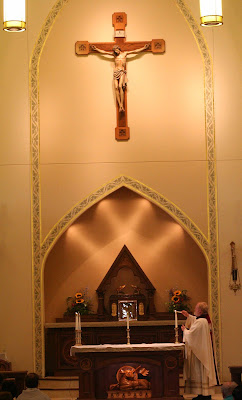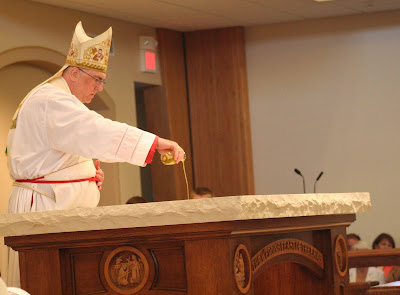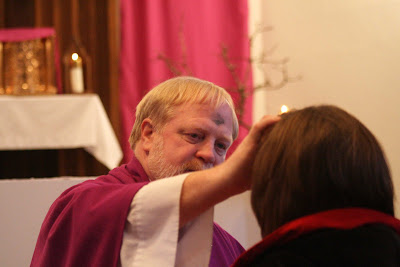 Exterior of St. Bernard Parish in Wamego. The church seats 600.
Exterior of St. Bernard Parish in Wamego. The church seats 600. Archbishop Joseph Naumann of Kansas City, Kansas was on hand to dedicate the new church.
Archbishop Joseph Naumann of Kansas City, Kansas was on hand to dedicate the new church. Church pastor, Father John Pilcher lights the candles in the church for the first time.
Church pastor, Father John Pilcher lights the candles in the church for the first time. Using sacramental oils, the archbishop anoints the altar.
Using sacramental oils, the archbishop anoints the altar.St. Bernard Church dedication a work of love for parishioners
Wamego’s St. Bernard Church dedicates “amazing” new church
By Paula Glover
The notion of a “once-in-a-lifetime event” could be the definition of the dedication of St. Bernard Catholic Church in Wamego on Sunday afternoon. After all, the church is intended to last longer than the lifetime of most of the people present when Archbishop Joseph Naumann, of the Archdiocese of Kansas City in Kansas presided over a dedication that is deeply rooted in the tradition of the Catholic Church.
With nearly 500 excited parishioners and community members present, Archbishop Naumann began by leading the parishioners (who had gathered outside in tents in the 95 degree heat) into their new church. There, the dedication Mass included a blessing of the water, a Litany of the Saints, with particular emphasis on Saints Pius X and John Vianney, whose relics were enclosed under the altar and altar of repose.
In his homily, Archbishop Naumann explained how buildings are symbols of what we value.
“We want to give God our best and give God our first fruits,” he said. He used the example of the beautiful churches built during the depression, or in small towns, that are “eloquent expressions of the praise of God in brick and stone.”
He contrasted that to the current emphasis on banks and centers of commerce as symbols of what we value. He noted that on a recent visit to St. Louis, the largest building was a casino. “God does not need us, but we erect good buildings to honor God,” he said. He encouraged all present to “honor God, open your hearts and be heroic witnesses to God as Christen men and women,” using the example of the saints.
An integral part of the dedication is placing of Chrism oil on the altar to dedicate it, and the archbishop poured the oil and spread it carefully over the entire altar. During the ceremony also, candles are lit to symbolize the light of Christ coming to the parish.
The archbishop praised Father John Pilcher, pastor of St. Bernard’s, for his leadership; and Father Pilcher in turn, praised the parishioners for their dedication to the project.
Richard Weixelman said the church was “phenomenal … the way the parish came together to the final project.” He said that 13 years ago, the committee started and one member moved away and two died, but all the others continued the drive for a new church.
One feature of the new church is an effort to utilize items from the old church, including the Crucifix, the stained glass windows (which were fully restored) and the Stations of the Cross.
Jim Meinhardt and his wife, Barbara, were involved during the process. Meinhardt said that the capitol campaign started in earnest two years ago, with a meeting that included about 60 people. One year ago in July, ground was broken for the building. Meinhardt noted a moment he would remember was when the beautiful ceiling was installed, and later on, as the final decorating was accomplished.
Barbara Meinardt noted that Father John was a leader in the restoration, with definite ideas on how the church should be structured. For example, the Tabernacle is in the center behind the altar and all the pews are forward facing. The church also features a large narthex, or gathering space, and a cry room. The church seats 500 and is designed to be able to be expanded.
“The church is amazing,” said parishioner Cindy Diederich. “It took my breath away to see it finished. It was so much more than I anticipated. I just stood there in awe. This really is a once-in-a-lifetime event,” she said, noting for example that nearby St. Joseph Church was dedicated in the early 1900s. “Father John is an amazing priest and our community is blessed to have him,” she added.
Father Plicher, for his part, said “The people did this work, I just happened to be their pastor.”
By Paula Glover
The notion of a “once-in-a-lifetime event” could be the definition of the dedication of St. Bernard Catholic Church in Wamego on Sunday afternoon. After all, the church is intended to last longer than the lifetime of most of the people present when Archbishop Joseph Naumann, of the Archdiocese of Kansas City in Kansas presided over a dedication that is deeply rooted in the tradition of the Catholic Church.
With nearly 500 excited parishioners and community members present, Archbishop Naumann began by leading the parishioners (who had gathered outside in tents in the 95 degree heat) into their new church. There, the dedication Mass included a blessing of the water, a Litany of the Saints, with particular emphasis on Saints Pius X and John Vianney, whose relics were enclosed under the altar and altar of repose.
In his homily, Archbishop Naumann explained how buildings are symbols of what we value.
“We want to give God our best and give God our first fruits,” he said. He used the example of the beautiful churches built during the depression, or in small towns, that are “eloquent expressions of the praise of God in brick and stone.”
He contrasted that to the current emphasis on banks and centers of commerce as symbols of what we value. He noted that on a recent visit to St. Louis, the largest building was a casino. “God does not need us, but we erect good buildings to honor God,” he said. He encouraged all present to “honor God, open your hearts and be heroic witnesses to God as Christen men and women,” using the example of the saints.
An integral part of the dedication is placing of Chrism oil on the altar to dedicate it, and the archbishop poured the oil and spread it carefully over the entire altar. During the ceremony also, candles are lit to symbolize the light of Christ coming to the parish.
The archbishop praised Father John Pilcher, pastor of St. Bernard’s, for his leadership; and Father Pilcher in turn, praised the parishioners for their dedication to the project.
Richard Weixelman said the church was “phenomenal … the way the parish came together to the final project.” He said that 13 years ago, the committee started and one member moved away and two died, but all the others continued the drive for a new church.
One feature of the new church is an effort to utilize items from the old church, including the Crucifix, the stained glass windows (which were fully restored) and the Stations of the Cross.
Jim Meinhardt and his wife, Barbara, were involved during the process. Meinhardt said that the capitol campaign started in earnest two years ago, with a meeting that included about 60 people. One year ago in July, ground was broken for the building. Meinhardt noted a moment he would remember was when the beautiful ceiling was installed, and later on, as the final decorating was accomplished.
Barbara Meinardt noted that Father John was a leader in the restoration, with definite ideas on how the church should be structured. For example, the Tabernacle is in the center behind the altar and all the pews are forward facing. The church also features a large narthex, or gathering space, and a cry room. The church seats 500 and is designed to be able to be expanded.
“The church is amazing,” said parishioner Cindy Diederich. “It took my breath away to see it finished. It was so much more than I anticipated. I just stood there in awe. This really is a once-in-a-lifetime event,” she said, noting for example that nearby St. Joseph Church was dedicated in the early 1900s. “Father John is an amazing priest and our community is blessed to have him,” she added.
Father Plicher, for his part, said “The people did this work, I just happened to be their pastor.”
Appeared in The Mercury, Aug. 27.



























